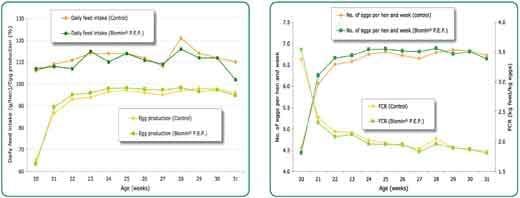Biomin Scientific trial with phytogenics in Lohmann Brown commercial layers

Aim of the Trial
The aim of the trial was to determine the benefits and economic advantages of phytogenics (Biomin® P.E.P. 125 poultry) in commercial layers in the early stages of the egg production cycle.
Trial Design
A 12-week trial was carried out with Lohmann Brown layers, using six replications with 16 birds per replication in a randomized complete block design and resulting in 96 hens per treatment. The age of the birds at the
beginning and conclusion of the trial was 20 and 32 weeks.
Treatment 1: Control (no additives)
Treatment 2: Control + Biomin® P.E.P. 125 poultry (125 g/t)
The birds were fed commercial diets according to breed standard (Table 1).
Feed in coarse mash form and water were provided ad libitum. The experiment was conducted in a closed house with tunnel air ventilation and evaporative cooling system. Birds were raised in single-type wire cages.
Lighting was available for 16 hours/day. All birds were vaccinated for Newcastle Disease and Infectious Bronchitis every six weeks. Both treatment groups were selected for the same live body weight prior to the
start of the trial.
| Table 1: Ingredient and nutrient composition of the basal diet | ||||
| Ingredients (%) | Chemical composition (%) | |||
| Corn | 55.02 | ME (kcal/kg) | 2850 | |
| Soybean meal | 27.81 | Crude protein | 17.50 | |
| Oyster shell | 27.81 | Crude fat | 6.95 | |
| Limestone | 4.00 | Linoleic acid | 1.73 | |
| Palm oil | 4.44 | Crude fiber | 4.97 | |
| L-Lysine HCl | 0.08 | Lysine | 1.00 | |
| DL-Methionine | 0.37 | Methionine | 0.60 | |
| L-Threonine | 0.04 | Methionine + Cystine | 0.86 | |
| MCP 15/20 | 1.48 | Calcium | 4.00 | |
| Salt | 0.35 | Phosphorus-total | 0.66 | |
| Vitamin-mineral premix | 0.25 | Phosphorus-available | 0.32 |
Results and Discussion
Daily feed intake and egg production are shown in Figure 1. Hens fed Biomin® P.E.P. consumed less feed and had a higher egg production as compared to the control group. As indicated in Table 2, total and average daily feed intake was lower by 1.8% when the birds were fed Biomin® P.E.P. at 125 g/t.
 | |
| To enlarge the image, click here | |
| Figure 1:Daily feed intake and egg production from week 20 to 31 | Figure 2:Number of eggs produced per hen and week and Feed Conversion Ratio (kg feed/kg eggs) from week 20 to 31 |
As illustrated in Figure 2, hens offered Biomin® P.E.P. produced more eggs and had a better feed conversion in comparison to control birds. The average values are shown in Table 2. Additionally, supplementation of the diets with Biomin® P.E.P. improved egg shell parameters (Table 3) such as shell thickness (P<0.05) and albumen height. As indicated by a higher Hugh Unit rating (82 vs. 79), the internal egg quality was higher in hens fed phytogenics.
Biomin® P.E.P. is based on a blend of essential oils and fermentable carbohydrates (prebiotics). A well-formulated combination of these ingredients has been shown to selectively support a beneficial gut microflora and to improve digestion in birds. Hence, supplementation of layer feed with Biomin® P.E.P. results in efficient utilization of energy and nutrients, thus improving production traits and performance parameters.
The economic calculation (Table 4) shows that phytogenics successfully improved productivity in egg production.
Addition of Biomin® P.E.P. to the diets for laying hens resulted in a 1.74% cost saving per egg produced.
| Table 2: Average performance parameters (week 20 to 31) | ||
| Control | Biomin® P.E.P. | |
| Daily feed intake per hen (g) | 112 | 110 |
| Total feed intake per hen (kg) | 9.42 | 9.26 |
| Egg production (%) | 92.6 | 93.5 |
| No. of eggs per hen | 77.8 | 78.6 |
| FCR (kg feed/kg eggs) | 2.069 | 2.034 |
| Table 3: Egg traits | ||
| Control | Biomin® P.E.P. | |
| Shell thickness (mm) | 0.416b | 0.478a |
| Albumen height (mm) | 6.57 | 7.09 |
| Haugh Units 1 | 79 | 82 |
| a,b Means with different superscript letters differ significantly (P<0.05) 1 Haugh Unit is a correlation between egg weight and albumen height. |
| Table 4: Economic calculation | ||
| Control | Biomin® P.E.P. | |
| Total feed consumption per bird | 9420 | 9260 |
| Feed cost per kg (THB) | 12.00 | 12.11 |
| Feed cost per bird (THB) | 113 | 112 |
| Feed cost per egg | 1.45 | 1.43 |
| Savings per egg produced (%) | 1.74 |
Conclusion
It can be concluded from the present data that supplementation of diets for laying hens with Biomin® P.E.P. positively affected performance and economic parameters in egg production. Since these improvements were seen in the early stages of production, it is assumed that similar or even higher improvements will also be obtained in the later stages of the production cycle.







.jpg&w=3840&q=75)